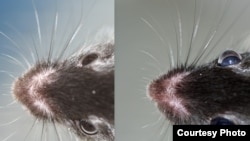A new study using laboratory mice points to the mechanism behind a leading cause of blindness. The research also points to a possible treatment.
The World Health Organization has listed glaucoma as the second leading cause of blindness, behind cataracts. Drugs and surgery can sometimes help, but better treatments could make a difference.
In glaucoma, a build-up of pressure in the eye can lead to damage to the optic nerve and loss of sight. Susan E. Quaggin, MD, of Northwestern University in Chicago explains that the eye is full of fluid and it is making new fluid all the time.
“And you can imagine, when you are making this fluid, it is just as important that you have a proper drainage system, so the fluid can escape," she explained in a telephone interview. “And if there is a problem with this drainage system, the fluid will build up, and this results in increased pressure.”
Quaggin and her colleagues identified a specific chemical signal or pathway in the body that is essential for a healthy drainage system to develop. Mice that were genetically modified to block that chemical signal quickly showed signs of glaucoma.
“Without this pathway, the drainage system does not develop, the pressure builds up, and glaucoma develops,” she added.
By identifying an essential chemical pathway for proper fluid drainage from the eye, Quaggin says her lab now has a target for a medicine that might help.
“Ultimately what we are trying to do is to develop an eye drop, a simple eye drop, that we could give to patients that will actually activate this pathway to improve drainage and to reduce pressure, and prevent blindness.”
The study by Northwestern University’s Susan Quaggin and her colleagues is published in the Journal of Clinical Investigation.




